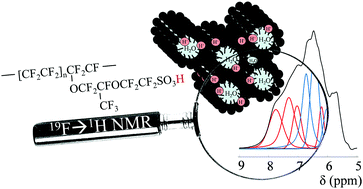Unlocking the observation of different proton populations in fluorinated polymers by solid-state 1H and 19F double resonance NMR spectroscopy†
Abstract
Nafion proton exchange membranes (PEMs) for fuel cell applications are extensively studied and commercially applied, but their unique proton conduction capabilities are still somewhat unexplained. For studying proton dynamics in situ, molecular level spectroscopic techniques have been of limited utility so far. By solid-state 1H and 19F double resonance nuclear magnetic resonance (NMR) spectroscopy using the recently revived multiple contact cross-polarization (MC-CP) pulse sequence along with double-quantum 1H–1H filtering, high resolution proton populations distinct from the dominant water resonance were observed in Nafion for the first time. This methodology quenches signal decay due to spin–lattice relaxation in the rotating frame and enables magnetization transfer between the relatively mobile 1H and 19F spin baths in Nafion. Further studies of these previously unrevealed proton populations will lead to a better understanding of the Nafion proton conduction mechanism and proton exchange processes in general.


 Please wait while we load your content...
Please wait while we load your content...